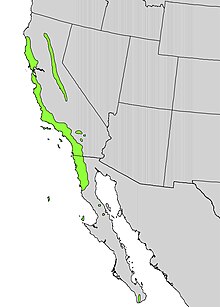
The MaloideaeC.Weber was the apple subfamily, a grouping used by some taxonomists within the rose family, Rosaceae. Recent molecular phylogenetic evidence has shown that the traditional Spiraeoideae and Amygdaloideae form part of the same clade as the traditional Maloideae, and the correct name for this group is Amygdaloideae. Earlier circumscriptions of Maloideae are more-or-less equivalent to subtribe Malinae or to tribe Maleae. The group includes a number of plants bearing commercially important fruits, such as apples and pears, while others are cultivated as ornamentals.
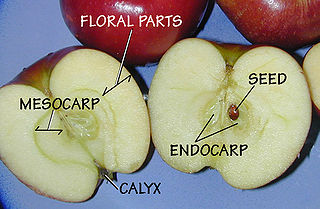
In botany, a pome is a type of fruit produced by flowering plants in the subtribe Malinae of the family Rosaceae. Pome fruits consist of a central "core" containing multiple small seeds, which is enveloped by a tough membrane and surrounded by an edible layer of flesh. Pome fruit trees are deciduous, and undergo a dormant winter period that requires cold temperatures to break dormancy in spring. Well-known pomes include the apple, pear, and quince.

Pyracantha is a genus of large, thorny evergreen shrubs in the family Rosaceae, with common names firethorn or pyracantha. They are native to an area extending from Southwest Europe east to Southeast Asia. They resemble and are related to Cotoneaster, but have serrated leaf margins and numerous thorns.

Aronia is a genus of deciduous shrubs, the chokeberries, in the family Rosaceae native to eastern North America and most commonly found in wet woods and swamps. The genus Aronia is considered to have 3 species. The most common and widely used is Aronia melanocarpa which emerged from Eastern North America. The lesser known Aronia arbutifolia and the hybrid form of the abovementioned species called Aronia prunifolia were first cultivated in Central and Eastern North America. In the eighteenth century, the first shrubs of the best-known species Aronia melanocarpa reached Europe where they were first cultivated in Scandinavia and Russia.

Photinia is a genus of about 30 species of small trees and large shrubs, but the taxonomy has recently varied greatly, with the genera Heteromeles, Stranvaesia and Aronia sometimes included in Photinia.

Coastal sage scrub, also known as coastal scrub, CSS, or soft chaparral, is a low scrubland plant community of the California coastal sage and chaparral subecoregion, found in coastal California and northwestern coastal Baja California. It is within the California chaparral and woodlands ecoregion, of the Mediterranean forests, woodlands, and scrub biome.
Christmasberry can refer to any one of several shrubs or small trees, as well as their colorful fruit:
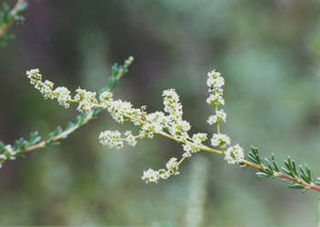
Adenostoma fasciculatum, commonly known as chamise or greasewood, is a flowering plant native to California and Baja California. This shrub is one of the most widespread plants of the California chaparral ecoregion. Chamise produces a specialized lignotuber underground and at the base of the stem, known as a burl, that allow it to resprout after fire has off burned its stems. It is noted for its greasy, resinous foliage, and its status as one of California's most iconic chaparral shrubs.

Holodiscus discolor, commonly known as ocean spray or oceanspray, creambush, or ironwood, is a shrub of western North America.

Frangula californica is a species of flowering plant in the buckthorn family native to western North America. It produces edible fruits and seeds. It is commonly known as California coffeeberry and California buckthorn.

Prunus ilicifolia is native to the chaparral areas of coastal California, Baja California, and Baja California Sur. as well as the desert chaparral areas of the Mojave desert.
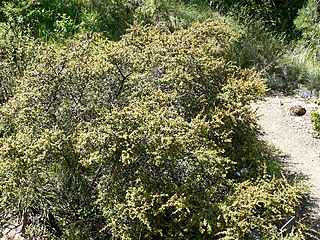
Rhamnus crocea, the spiny redberry, is a species of plant in the family Rhamnaceae. It is native from California to northern Mexico. As of March 2024, five subspecies are recognized.

Ceanothus crassifolius is a species of flowering shrub known by the common name hoaryleaf ceanothus. This Ceanothus is found throughout the coastal mountain ranges of the southern half of California, and its range extends into Baja California.
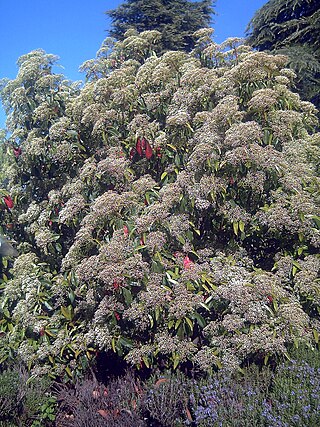
Photinia serratifolia, commonly called Taiwanese photinia or Chinese photinia is a flowering shrub or tree in the flowering plants family Rosaceae, found in mixed forests of China, Taiwan, Japan, the Philippines, Indonesia, and India.
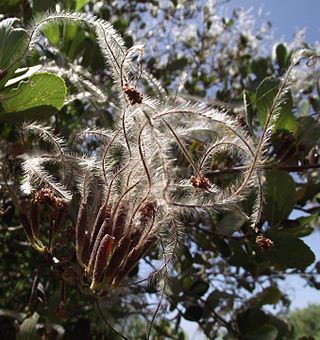
Cercocarpus betuloides is a shrub or small tree in the rose family. Its common names include mountain mahogany and birch leaf mountain mahogany The common name "mahogany" comes from the hardness and color of the wood, although the genus is not a true mahogany.
In botany, an obconic is an inverted cone shape. The term is most frequently applied to certain fruit or hypanthium structures with the apical end attached to the stem; however, less frequently the usage may apply to the pistil structure. In the case of fungi the designation is often made to the ascospore. The use of obconic in botany dates to at least as early as the nineteenth century; however, some modern usage applies to an entire plant form, such as the shape of a whole shrub. More broadly, in geometry or design, the term can be assigned in an abstract manner to shapes in the natural or man-made world which show an inverted cone design.

The Maleae are the apple tribe in the rose family, Rosaceae. The group includes a number of plants bearing commercially important fruits, such as apples and pears, while others are cultivated as ornamentals. Older taxonomies separated some of this group as tribe Crataegeae, as the Cydonia group, or some genera were placed in family Quillajaceae.

Malinae is the name for the apple subtribe in the rose family, Rosaceae. This name is required by the International Code of Nomenclature for algae, fungi, and plants, which came into force in 2011 for any group at the subtribe rank that includes the genus Malus but not either of the genera Rosa or Amygdalus. The group includes a number of plants bearing commercially important fruits, such as apples and pears, while others are cultivated as ornamentals.

Asphondylia photiniae, also known as the toyon fruit gall midge or toyon berry gall midge, is a species of midge that induces galls on the developing berries of the toyon bush in North America. Galled berries stay green and look somewhat warped. Each galled berry contains a single larva, which emerges in spring. This midge is known from the Californias, where native Heteromeles arbutifolia grows in relative abundance.

